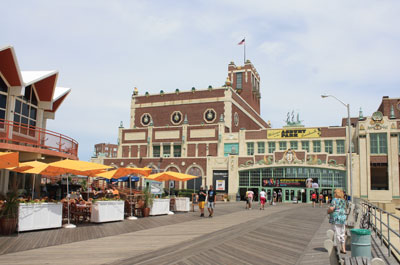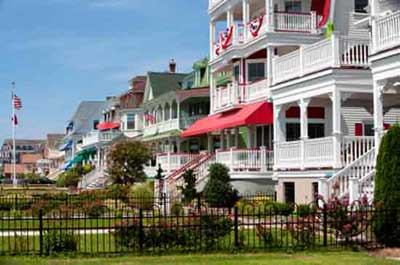New Jersey Coastal Heritage Trail
A joining together the Jersey shore areas with Coastal Habitat, Maritime Heritage, and Wildlife Migration.
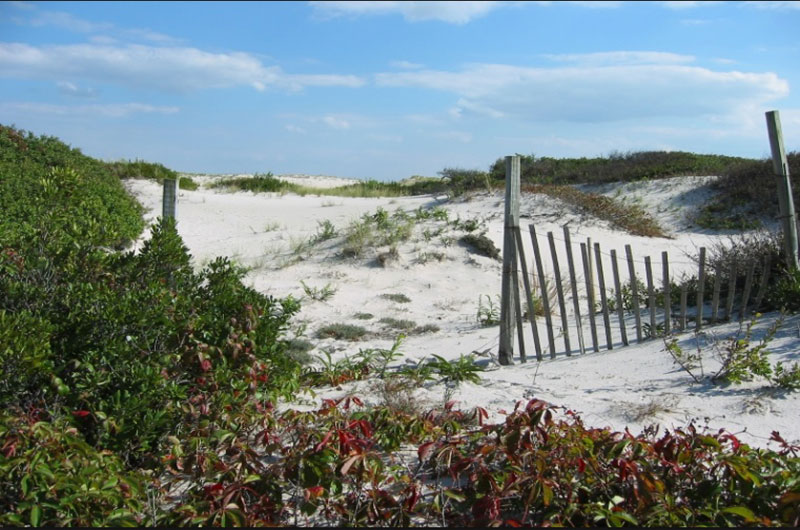
The New Jersey Coastal Heritage Trail is not really a trail, it is a route designed to be leisurely seen by auto for the benefit of the public to provide education, understanding, and enjoyment of natural, maritime, and cultural sites of the coastal area of New Jersey.
The concept is to join together the Jersey shore areas into five regions with three major themes; Coastal Habitat, Maritime Heritage, and Wildlife Migration.
The trail hugs the coastline of New Jersey and runs nearly 300 miles, being divided into regions from Sandy Hook Region along New York Harbor, south to Barnegat Bay Region, the Absecon Cape May Region, and the Delsea Region along Delaware Bay. You will be able to meander along the area east of the Garden State Parkway from the Raritan Bay south to the area north and west of Cape May and south of Route 49 to the vicinity of Deepwater.
The trail includes many New Jersey state parks and facilities with all of the Trail's destinations loosely owned and operated by other agencies and organizations. Since September 30, 2011, as a result of a sunset clause, the National Park Service is no longer the legislative authority to be involved in the management of the Trail. At this time there is no single authority responsible for the management of the trail, although there are legislative efforts to reinstate the NPS as the legislative authority
Although The New Jersey Coastal Heritage Trail Route is designed for vehicular touring, it connects areas of interest to hikers. In addition to the five themes, The Coastal Heritage Trail is divided into five regions, linked by the common heritage of life on the Jersey Shore and the Raritan and Delaware bays.
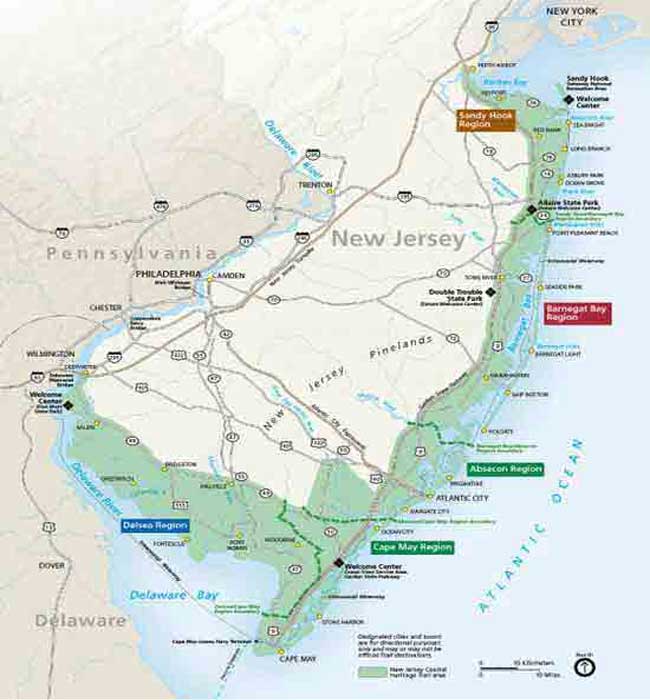
Visitors Will Experience

From your vehicle, The Coastal trail will take you along a fascinating journey past lighthouses, beautiful sandy beaches and dunes, fishing villages, reclaimed marshes with wildlife, and cranberry bogs.
Along the route of the New Jersey Coastal Heritage Trail, the visitor will experience fresh water creeks and tidal marshes that can be ideal for canoeing, kayaking, and camping. Rentals are available from local outfitters. There are also many bike routes along the New Jersey Coastal Trail.
Coastal Heritage Themes
Coastal Habitat-See the large variety of coastal species and habitat, and learn about the habitat and the importance and value of species diversity and habitat maintenance.
Maritime heritage-Here you can experience the history of trade, navigation, and coastal defenses. The ocean, bays, rivers, and tributaries were key to the fishing industry, boat building and other maritime activities. Lighthouses were erected as maritime navigational aids to warn mariners of hazards to their ships and prevent loss of crew and cargo.
Wildlife Migration-New Jersey's coastal regions provide critical habitat for many migrating species in the Western Hemisphere. The New Jersey coast is a critical route for the migration of many birds, marine animals, and insects. Dolphins, whales, seals, fish, hawks, eagles, warblers, and butterflies are many of the animals that nurture on New Jersey's coastal habitats. The visitor learn about the habitats that serve as seasonal refuges for the migrating species.
Trail Regions
Here is what you can experience in each of the Five Coastal Heritage Trail regions.
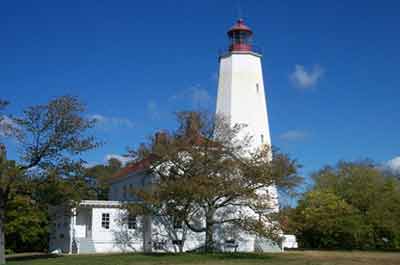
The regions highlights are: Sandy Hook where you can enjoy the beach with a view of the New York City skyline. Mount Mitchill at 266 feet above sea level, it's one of the highest points on the East Coast. Fort Hancock, the location of the Sandy Hook Lighthouse. The Steamboat Dock Museum In Keyport to get an understanding of the settlement as a private plantation in 1714.
Take A short drive south to Ocean Grove where you can visit this charming village with Victorian homes and a 6,000-seat Great Auditorium and visit one of the first religious resorts on the Shore.
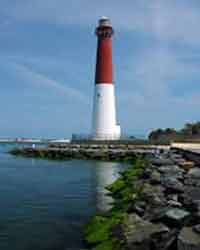
Barnegat Bay borders the barrier islands and the communities with a rich maritime history and love of the ocean. Visit for a view of the coastline and inlet. Stop by Double Trouble State Park and enjoy the Pinelands, cedar swamps, and the 1800s village. The Toms River Seaport Society Museum where you can learn about the inventor of the corrugated metal life car that saved thousands of lives in shipwrecks. Island Beach State Park, a beautiful beach with sand dunes and a good example of a barrier island ecosystem. Barnegat Bay Decoy & Bayman's Museum, a replica hunting shanty with display's of a decoy carver's work. Cattus Island State Park, home of the Cooper Environmental Education Center. Grate Great Bay Boulevard Wildlife Management Area with almost 4,00 acres of salt marsh and nesting shore birds. Eno's Pond County Park which shares trails with the Edwin B. Forsythe National Wildlife Refuge.
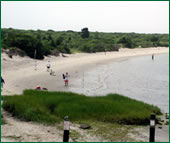
Absecon Region
Encompasses Corson's Inlet State Park , one of the few undisturbed stretches of Atlantic coastline left between Atlantic City and Cape May
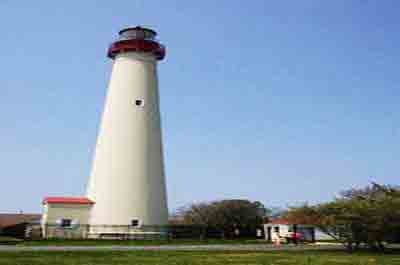
The regions highlights include The best white, powdery sand beaches along the east coast. The Hereford Inlet Lighthouse. The Cape May National Wildlife Refuge where you can witness the fall bird migration as they cross Delaware Bay. Cape May Lighthouse situated on 6,000 acres of coastal wetlands with exhibits, an observation tower and nature trails. Higbee Beach Wildlife Management Area. Stop by the Village of Cape May,a charming town with Victorian homes, shops, and fine restaurants.
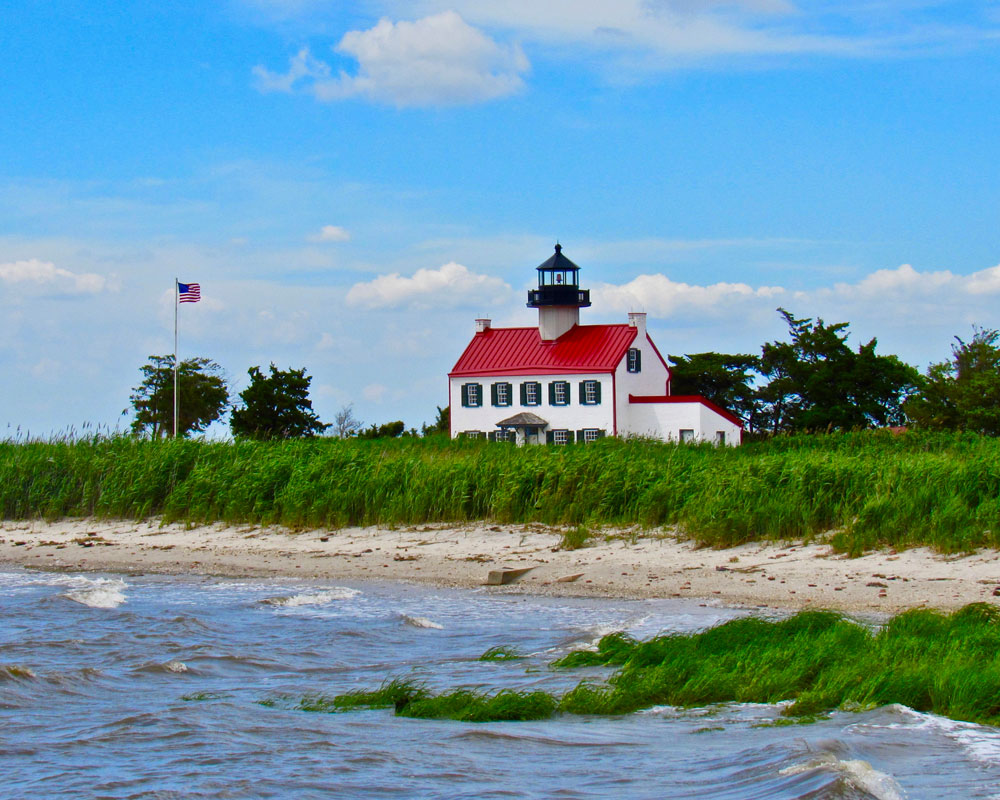
The Regions highlights are: Eldora Nature Preserve, former home of renowned entomologist Dr. C. Brooke Worth. Bellplain State Forest. The East Point Lighthouse. Pesalee Wildlife Management Area.

